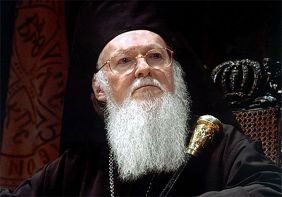Message from Patriarch Bartholomew I
X International Liturgical Conference
IDENTITY AND TRANSFORMATION:
The liturgical adaptation of churches
Bose, 31 May - 2 June 2012
Monastery of Bose
Italian bishops' conference - National office for the Church's cultural heritage
beloved brothers and sisters,
distinguished delegates and participants,
It is with great joy that we communicate with the organizers and participants of this year’s 10th International Liturgical Conference in order to address a personal greeting and bless this auspicious scholarly gathering, which is being held in collaboration with the National Office for the Church Cultural Heritage of the Italian Bishops’ Conference. You have selected as your fundamental theme the crucial subject of “Identity and Transformation: the liturgical adaptation of the churches.”
Very often, people perceive the Church as an unchanging reality, as an institution that is not subject to any form whatsoever of adaptation or development, but instead remains identical or unaltered through the centuries. It is, of course, our conviction that “Christ is the same yesterday and today and forever” (Heb. 13.8), and we have been assured that “the gates of hell shall not prevail against the church” (Matt. 16.18) Moreover, the Church Fathers have definitively stated: “We keep the tradition just as we have received it” (St. John of Damascus, On the Divine Images II, 12), while more recently the Eastern Patriarchs unanimously declared that “we neither add nor take away anything from the tradition” (Letter of the Eastern Patriarchs, 1718).
This, however, is only one side of the Church. If people take into consideration this dimension alone, then their perspective of the Church is surely incomplete, even severely unbalanced. The steadiness and changelessness of the Church comprise only one side of the story. In reality, there has always been growth and evolution. Over the centuries, the Church has experienced transformation and change, but it is the almost seamless transformation and change of a living organism. It is the almost imperceptible development of a breathing institution, namely the Body of Christ.
It is precisely for this reason that we must at all times examine the experience and practice of the Church through the ages, rather than focusing exclusively on a single epoch – whether this be a golden age or a period of decline. Indeed, we could be so bold as to say that we should also explore the diverse models and applications of the Church across liturgical or cultural reference – whether this be a purely architectural or devotional context.
This is why we are especially pleased that your conference will review a broad spectrum of liturgical adaptation in churches: from historical to modern, from cathedral to monastic, from iconographic to architectural, and from traditional to reformed.
It is our prayer and anticipation that you will in this way appreciate how identity and transformation are in fact deeply intertwined and inseparable. For, in the final analysis and beyond all analysis, identity always flourishes in transformation; and at the same time, transformation always endures in identity.
We convey to all of you our most fervent wishes for successful and fruitful deliberations.
Prayerfully yours,
+ Bartholomeos
Archbishop of Constantinople-New Rome
and Ecumenical Patriarch
